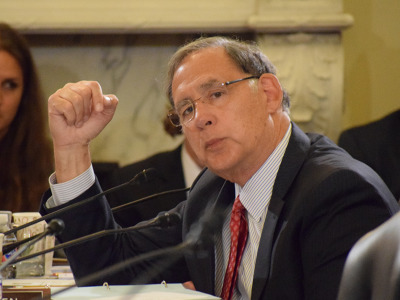Farmers will get some welcome relief starting next month from the market impact of the coronavirus, but it will take a second round of payments to keep many in the black this year, and producers may face similar problems into next year.
The Agriculture Department began enrollment Tuesday for $16 billion in direct payments under the new Coronavirus Food Assistance Program, but it’s not certain yet how much producers will get in additional aid beyond that.
The $3 trillion HEROES Act, which passed the House earlier this month, would authorize an additional $16.5 billion in payments. The Republican-controlled Senate isn’t taking up the bill, and GOP leaders haven’t said for sure what they want to include in their version of a new COVID-19 aid bill beyond liability protections for business.
According to a University of Illinois analysis, many corn and soybean growers will be at the break-even point only if Congress and USDA authorize a second round of payments such as the House bill would authorize.
Row crop farms “will be able to manage 2020 with government aid. It’s 2021 we’re really concerned about,” said Illinois economist Gary Schnitkey.
The analysis projects that a central Illinois farm with acreage evenly divided among corn and soybeans would lose an average of $2 an acre, and that’s assuming a second round of payments. That compares to a profit of $6 an acre for the 2019 crop, including the initial CFAP payment, and $104 per acre in 2018.
The prospects for the 2021 crop without heavy government support are dim. Assuming no CFAP or Market Facilitation Program payment in 2021, the loss for that same corn-soybean farm would balloon to $59 per acre, based on an average projected loss of $78 an acre on corn and $40 an acre on soybeans.

Gary Schnitkey, University of Illinois
Before the COVID-19 crisis, the price on the 2019 corn crop was expected to average $3.85 and fall to $3.70 for 2020 and $3.60 for 2018. Now, based on current futures prices, the 2019 crop price is expected to average just $3.55, and the 2020 and 2021 prices are estimated at $3.55 and $3.25, respectively. The crop year for corn and soybeans runs from September of the year the crop is harvested through the following August.
And those projections are based on a “recovery that frankly in my mind would be pretty quick,” said Schnitkey. “What we’re building in here is the case that ethanol and ethanol use comes back, and we’re getting our export demand back and we get livestock demand back.”
The projection also assumes trend yields for corn. If corn yields are higher this year, presumably prices will be lower and stocks will be higher going into 2021, further depressing prices.
For soybeans, pre-coronavirus prices rose to $8.70 for 2021. Post-coronavirus prices are now projected to be $8.55 for the 2019 crop, $8.20 for 2020 and $8.30 for 2021.
Schnitkey recommends 2021 rental contracts include a clause that would link rent to whether or not there is another round of CFAP or MFP-type payments next year.
Other commodities could be in a similar situation in 2021, including cotton and livestock, said John Newton, chief economist for the American Farm Bureau Federation.
USDA estimates cotton prices fell 25% from January to April, compared to a 16% drop for corn and a 10% decline for soybeans. Cattle prices were down 15% to 16% over the same period.
Dan Basse, president of AgResource Co., says corn and soybean farmers would be posting sizable losses this year, the largest since the 1980s, without the coming government payments. Government payments may account for as much as 40% of total farm revenue, “which means that every U.S. farmer is farming for the government in 2020/2021,” he said.
The $16 billion in CFAP payments that farmers can now sign up for is primarily designed to cover losses on 2019 crops. Payments for row crops, for example, will be calculated based in part on how much a farmer had in storage in January. The $16.5 billion included in the House’s HEROES Act would compensate for losses on 2020 crops, using the CFAP model and expanding the assistance to additional unspecified commodities.
Arkansas GOP Sen. John Boozman, who is in line to become chairman or ranking member of the Senate Agriculture Committee next year, tells Agri-Pulse he thinks Congress will ultimately authorize more assistance than was in the House bill by raising USDA’s spending authority under the Commodity Credit Corp. to around $50 billion. The limit since the 1980s has been $30 billion.

Sen. John Boozman, R-Ark.
“The public is being very supportive of the fact that we do need to support our farmers,” Boozman told Agri-Pulse. “They’re just in a unique situation right now. I would look forward to additional funds being spent” in 2020.
He also said that the assistance could be expanded to contract poultry growers, catfish farmers and ethanol producers.
“I think there will be an effort to help many, many groups that perhaps haven’t been helped up to now,” Boozman said.
Interested in more coverage and insights? Receive a free month of Agri-Pulse or Agri-Pulse West by clicking here.
Senate Majority Leader Mitch McConnell, R-Ky., told reporters in his home state on Tuesday that the next bill would be smaller than the $3 trillion HEROES Act, The Hill newspaper reported. “But there's still a likelihood that more will be needed,” he said.
Republicans also have ruled out extending the $600 per month in supplemental unemployment benefits. But other major issues are still the subject of negotiation.
McConnell has insisted on providing businesses some protection from lawsuits by employees and consumers who contract COVID-19, an issue that has been a concern to farms and food processors.
House Majority Leader Steny Hoyer, D-Md., on Tuesday signaled that the issue was open to negotiation, noting that 3M was given liability protection for personal protective equipment. The issue is “open to discussion, but we want to make sure that consumers and patients are protected,” he said.
For more news, go to www.Agri-Pulse.com.


